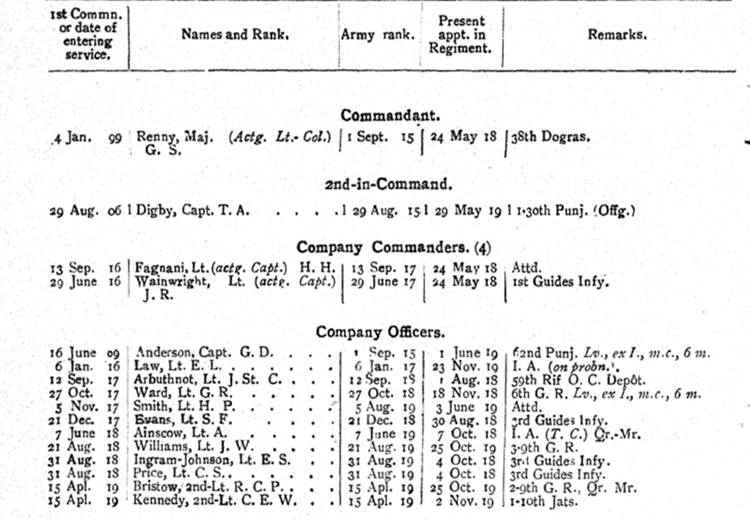This article on the 3rd Battalion 151st Punjabi Rifles and will help you to research this war-raised Battalion and those served with it. I have written separate articles for the other two Battalions of the Regiment and guides to help you research soldiers who served in the Indian Army:
The 3rd Battalion 151st Punjabi Rifles
Lineage: Formed in Egypt in May 1918 and disbanded on 15 May 1921.
Class Composition of Battalion in 1919: 1 1/2 Companies of Punjabi Muslims, 1/2 a Company of Gurkhas, 1 Company of Dogras, 1/2 a Company of Rajputs and 1/2 a Company of Ahirs.
The 3rd Battalion 151st Punjabi Rifles was a war-raised Indian Infantry Battalion formed at Latron, Egypt in May 1918. The Battalion was one of eighteen new Indian infantry battalions created to replace British battalions withdrawn from the Middle East to France in consequence of the German Spring Offensive. The 3rd Battalion 151st Punjabi Rifles was formed from:
- B Company, 1st Battalion Guides Infantry
- B Company, 38th Dogras
- D Company, 58th Vaughan’s Rifles Frontier Force
- D Company, 59th Scinde Rifles Frontier Force
The Battalion served in the Palestine Campaign and took part in the Battle of Megido in September 1918. There is a war diary covering the Battalion’s activities between May 1918 and January 1919 but it isn’t very detailed. The Battalion remained in the Middle East after the war, returning to Egypt in November 1918. While in Egypt the Battalion was stationed at Kantara and Alexandria before moving to Belbeis in January 1919. The 3rd Battalion 151st Punjabi Rifles was disbanded on 15 May 1921.
The extract below is taken from the July 1919 Indian Army List and records the British officers who were then serving with the Battalion. I have a page to help you decipher all the military jargon which you will find when you consult the books: Indian Army Abbreviations and Acronyms.
War Diary of the 3rd Battalion 151st Punjabi Rifles
There is only one war diary for the 3rd Battalion 151st Punjabi Rifles which hasn’t been digitized and can only be viewed at the National Archives. I have transcribed some entries at the bottom of the page.
- Date: 24 May 1918 – 31 January 1919
- 179th Infantry Brigade, 60th (London) Division, Egyptian Expeditionary Force
- Reference: WO 95/4668
- Notes: The only war diary for the 3rd Battalion 151st Punjabi Rifles which provides an overview of the unit’s activities but is not that detailed. Contains a large number of appendices, mostly concerning orders. Also, includes a 5-page report on raid a raid carried out on Turmus Aya on the night of 12/13 August 1918.
Further Sources for the 3rd Battalion 151st Punjabi Rifles
For information regarding British and Indian officers who served in the 3rd Battalion 151st Punjabi Rifles, the Indian Army List can be consulted. There was no regimental history produced fo the 151st Punjabi Rifles. There is a confidential report for the Battalion’s Depot for 1920-21 which also includes the confidential reports of officers serving with the Depot:
- Collection 405/26 Review reports on certain units of Indian Army 1920-1921: IOR/L/MIL/7/17032.
Extracts from the war diary of the 3rd Battalion 151st Punjabi Rifles
24 May 1918 – 31 January 1919, Egyptian Expeditionary Force, WO 95/4668
24 May 1918 – Latron – 10.00 hours – B Company 1 Guides Infantry. Strength: British Officers 2. Indian Officers 3. Indian Other Ranks 228. Followers 9 arrived. – D Company 58th Rifles. Strength: British Officers 2. Indian Officers 3. Indian Other Ranks 170. Followers 10 arrived.
28 May 1918 – Ludd – Mobilization stores and equipment drawn from ordnance.
05 – 11 June 1918 – Ram Allah (Jerusalem U15 Central) – Road making. Specialist training as far as possible carried out.
20 – 27 July 1918 – Trench routine carried out. Patrols visited KH. Amurieh (Telfik L5B) nightly, encountering enemy on three occasions. Casualties 1 Indian Other Rank wounded. Occasional shelling by enemy on company day HQ. Casualties 3 Indian Other Ranks wounded.
27 July 1918 – Regiment relieved by 2nd Battalion 127th Baluch Light Infantry and proceeded to Brigade reserve at K7 Central (Telfix), two companies manning reserve position on Yeoman’s Hill.
28 – 31 July 1918 – Yeoman’s Hill (K12) – In Brigade reserve. Supplied working parties to various units and improved defences on K12. Specialist training carried on as far as possible.
03 July 1918 – U15 B- Drill attacks by companies and more practice in loading camels for transit.
04 July 1918 – U15 B- Special attention paid in attacking drill to supply of ammunition. Difficulty in storing water, as tanks not yet supplied.
04 – 12 August 1918- Training for raid on Turmus Aya (J28D) carried out in additional to usual work in line.
10 August 1918 – Jemadar Chennu Khan wounded (remained at duty).

